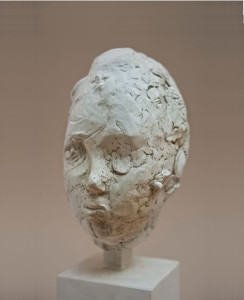The Degas Debate: Analyzing the Controversial Plasters
Are 74 plasters ‘discovered’ in a foundry storeroom ‘original’ works by Degas? A Degas scholar analyzes the sculptures, outlines the controversy, and considers competing meanings of ‘original’
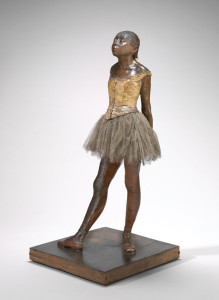
The only sculpture Degas ever exhibited was the Little Dancer Aged Fourteen, 1878–81. Made of wax, with real hair, the figure wears a cotton faille bodice, multilayered tutu, and linen slippers. Controversial when it was shown at the 1881 Impressionist exhibition, it is at the center of another controversy today. NATIONAL GALLERY OF ART, WASHINGTON, D.C., COLLECTION OF MR. AND MRS. PAUL MELLON
Posthumous reproductions have played a contentious role in the artistic legacies of Auguste Rodin, Edgar Degas, and other important sculptors who died in the early 20th century. Debates among connoisseurs about what counts as “original labor” or an “authentic copy” are often confusing and sometimes open to lawsuits. Nevertheless, sculpture created by an artist with his or her own hands usually counts as “original” and typically serves as a benchmark in determining the authenticity of copies.
Recently, dealers marketing bronzes cast from plaster replicas of Degas’s handmade sculptures have proposed a novel twist to these standard assumptions. Their bronzes and plasters differ—radically in some cases—from Degas’s existing originals, not because they are inaccurate copies, the dealers say, but because these bronzes and plasters are, in effect, more original.
According to Leonardo Benatov, current owner of the Airaindor Valsuani Foundry outside of Paris, the plaster versions were part of the inventory when he purchased the Valsuani Foundry in 1980. In the 1990s, after the copyright on Degas’s sculpture had expired, Benatov cast several of these plasters in bronze, including two editions based on Degas’s celebrated The Little Dancer Aged Fourteen. Benatov later granted New York dealer Walter Maibaum the exclusive right to sell full sets of bronzes made from the Valsuani plasters.
Maibaum and Benatov initially assumed that the plasters were posthumous casts created by Albino Palazzolo, the expert who supervised the casting of Degas’s original wax, clay, and plastiline sculptures in bronze at the Hébrard Foundry in Paris after the artist’s death in 1917. The resulting Hébrard bronzes are in major museum collections throughout the world.
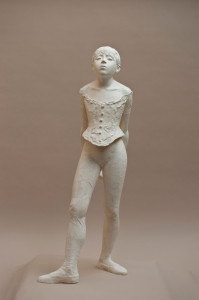
The Valsuani plaster Little Dancer is a heavier, more muscular figure, standing with hips squared and weight distributed equally on both feet. OLIVIER BRUNET.
In 2005, Gregory Hedberg, now a senior consultant at New York’s Hirschl & Adler Galleries, examined the Valsuani Little Dancer plaster and decided that this “magnificent” cast was not, in fact, a posthumous copy but was instead a plaster made during Degas’s lifetime. Hedberg subsequently decided that nearly all the Valsuani plasters were casts made during the artist’s lifetime from his original wax and clay sculptures. Since then, at least eight sets of Valsuani bronzes based on these plasters have been sold for prices said to be in the range of $7 million.
As ARTnews has reported in previous articles, no major Degas sculpture specialist has expressed agreement with Hedberg’s view. Gary Tinterow, former head of European painting at the Metropolitan Museum of Art and now director of the Museum of Fine Arts, Houston, told ARTnews that “there is nothing that demonstrates that Degas had a set of plaster casts made of his sculptures during his lifetime.” Yet the Valsuani bronze sculptures continue to attract buyers. The Valsuani plasters Benatov says he found in 1980 have been sold to private collectors as well. The Valsuani plasters illustrated in this article are copies of the plasters now in private collections, and are currently in use at the Valsuani Foundry.
In a 2010 letter to ARTnews, Hedberg summed up his understanding of the disagreements between the dealers and the scholars. The “key issue boils down to this,” he wrote: The dealers believe that the similarities between the Hébrard and Valsuani sculptures are “due to the fact that the [Valsuani] plasters were cast from Degas’ original waxes . . . while Degas was alive.” The differences in appearance came about because Degas “repaired and reworked some models. Then, after Degas’ death, additional repairs were made.” The dealers reason that if the Valsuani plasters represent the artist’s first versions of his figures, before later or posthumous changes were made, they should be recognized as records of his original vision.
Hedberg characterizes the view of the scholars on the other side as follows: they believe that the Valsuani plasters “record extraordinary copies made by some highly skilled sculptor who at times faithfully recorded Degas’ original waxes and at other times made his or her own variations.”
None of the major Degas specialists has commented in print on this possibility. But Hedberg’s proposal does offer an intriguing set of options when we turn to specific examples.
Some of the more notable differences in appearance between a Valsuani plaster and a sculpture modeled by Degas’s own hand are to be found in the artist’s well-known figure The Little Dancer Aged Fourteen. First shown at the 1881 Impressionist exhibition in Paris, the Little Dancer is the only sculpture Degas exhibited during his lifetime. This wax figure, along with most of his lifetime wax sculptures, is in the National Gallery of Art in Washington, D.C.
The Little Dancer is slim, with long, sinewy legs and her feet splayed in a casual fourth position. Most of the figure’s weight rests on the straight left leg; the extended right leg is slightly relaxed. Achieving this pose pushes the hips into a contrapposto position, with the left hip higher and at an oblique angle to the right.
In contrast, the Valsuani plaster Little Dancer exhibits a different pose and body type. The upper legs are conspicuously heavier and more muscular; both knees are slightly bent; weight is distributed equally on both feet; and the hips are squared to the front. The collarbones and neck muscles are more prominent than those of the wax, and the hairstyle is quite different when viewed from the rear.
The faces of the two figures also differ. The plaster face is more regular, almost conventionally pretty, and relatively serene, with fuller, lowered eyelids casting deep shadows over the eyeballs. The eyelids of the National Gallery wax figure, in contrast, are half closed, and the pupils are incised to suggest a downward gaze. The right eye has a slightly different shape than the left. These details play into an effect that senior Degas scholar Theodore Reff has described as “a sense of strain or suffering, reflecting her effort to maintain her awkward posture and, mingled with it, a vaguely sensual yearning, especially in the half-closed eyes.”
The Valsuani Little Dancer, according to Hedberg, is not an inaccurate copy of the wax sculpture now in the National Gallery. Nor is it a cast made from that figure. The differences between the Valsuani plaster and the National Gallery wax, he argues, result from an undocumented decision by Degas to rework his composition after completing a first version.
Hedberg believes that the wax figure in the National Gallery—the model for the familiar Hébrard bronzes with tutus displayed in museums all over the world—was not the figure Degas exhibited in 1881. That figure is represented instead by the Valsuani plaster. The National Gallery dancer, he says, is an anatomically inferior, second version of the 1881 figure, probably created around 1903.
Thus, according to his logic, the Valsuani plaster represents the original version, while the existing wax Degas modeled by hand should be recognized as a mannered later variation of his original concept.
Contrary to a long history of Degas scholarship, Hedberg writes in a catalogue accompanying exhibitions of the Valsuani sculptures that “although extremely popular, no connoisseur of 19th-century sculpture ranks Degas’ second version as an unqualified masterpiece.” The first version of the Little Dancer recorded in the Valsuani plaster and bronzes, he says, is “a masterpiece that can rival any work of art ever produced by the greatest artists of all time.”
Hedberg faces a number of obstacles in building support for his new history of the Little Dancer. There are no photographs of the 1881 Impressionist exhibition, and no letters by the artist related to the Little Dancer project survive. Contemporary viewers of the exhibition were remarkably inconsistent in their descriptions of the dancer’s size, costume, skin, hair, and social identity. As Degas scholar Richard Kendall has observed, these discrepancies indicate that “Degas’ diminutive ballerina proved as disorienting to audiences as the grandest projects of the day, overturning assumptions, crossing the frontiers of propriety and apparently threatening the identity of sculpture itself.”
The Little Dancer was never exhibited again, although the figure was on view in Degas’s studio. Shortly after the artist’s death, inventory photographs of his sculpture were taken, including three images of the wax Little Dancer now in the National Gallery. In these photos, the dancer looks very much the same as it does today.
If Hedberg is correct, we should accept that the National Gallery’s wax Little Dancer is the same sculptural object as the figure recorded in the Valsuani plaster, and that, decades after he created the Valsuani figure, Degas transformed his original, static, level-hipped, large-legged 1881 model into a thinner, young dancer with long shins and thigh muscles and a new face, standing in a different pose.
This unique theory is difficult to square with relevant technical studies and visual documents. The best evidence for the sculpture’s original conception and development consists of several drawings of the model for the sculpture, Marie van Goethem. In 1879, the 14-year old Marie was a second-year student in the dance school of the Paris Opera, and in 1880 she was recruited for the Opera Ballet. There are more drawings of Marie than of any other Degas model (at least 16, according to Reff). Dance historian Jill DeVonyar, who has cocurated several exhibitions of Degas’s work, writes that drawings of Marie show a model “blessed with considerable physical gifts: good turn-out, long limbs, flexion in her ankles and a supple back.”
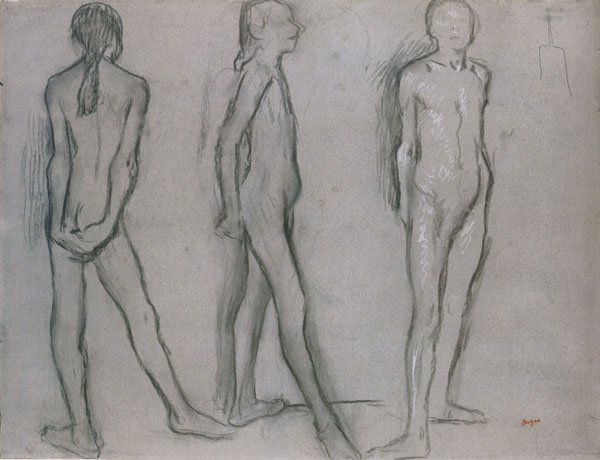
The 14-year-old Marie van Goethem was Degas’s model for the Little Dancer. He sketched the armature he intended to use in making the wax sculpture at top right. PRIVATE COLLECTION, LONDON.
In many of the drawings, Marie wears a tutu covering her upper legs. There are several studies of Marie in the nude, however, illustrating the same figure type, with the hips, legs, and right foot in the same position as the National Gallery dancer. As far as we know, the Little Dancer was Degas’s most ambitious early sculpture. Kendall has proposed that the nude drawings served as traditional preliminary studies, and represent “a cautious temporary return to routines of his youth by an artist facing an unfamiliar challenge.” The nude drawings are characteristic of Degas’s graphic style around 1878–80. None resembles the figure represented in the Valsuani plaster.
One series of nude drawings includes a sketch of the basic armature Degas used to create the National Gallery sculpture. Degas’s armature also plays a key role in assessing Hedberg’s claim that the National Gallery sculpture is a revised second version of a Valsuani original.
In 2010, the National Gallery published Edgar Degas Sculpture, an unprecedented systematic catalogue of the wax, clay, and plastiline sculpture Degas created during his lifetime. For this catalogue, National Gallery conservators Shelley G. Sturman and Daphne S. Barbour, together with three National Gallery scientists, carried out detailed technical studies of the Degas sculptures in the gallery’s collection. The studies included three-dimensional computer models; laser scans; x-radiography; and spectroscopic, chromatographic, and microscopic analyses. With these technologies, the conservators and scientists were able to track the physical histories of the sculptures and document alterations and repairs made during and after the artist’s lifetime.
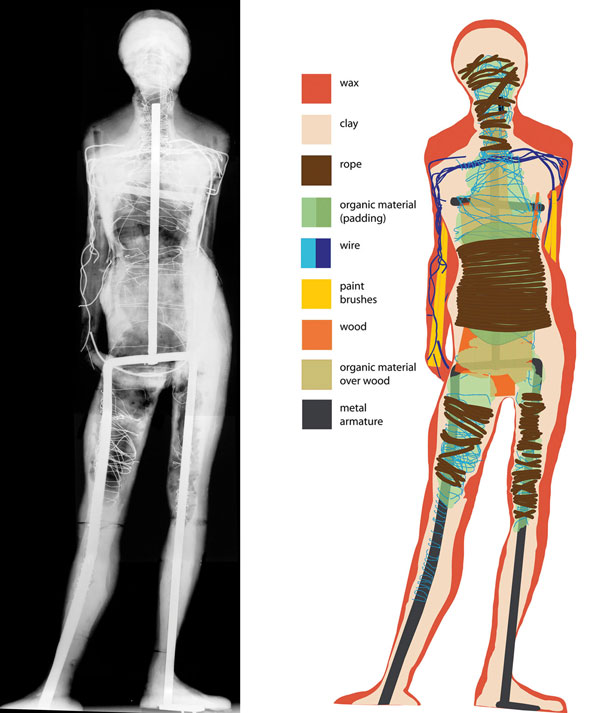
The complex construction of Degas’s wax Little Dancer is visible in a radiograph (left) and a schematic diagram of the inner armature (right). The figure was examined by a team of conservators and scientists at the National Gallery of Art.LEFT: ©2011 NATIONAL GALLERY OF ART, WASHINGTON, D.C.; RIGHT: ILLUSTRATION BY JULIA SYBALSKY AND ABIGAIL MACK/©2007 NATIONAL GALLERY OF ART, WASHINGTON, D.C.
They confirmed that the most conspicuous posthumous revisions resulted from the removal of Degas’s external armatures and their replacement in many cases with new supports. Some of these interventions occurred when Palazzolo prepared the sculptures for casting at Hébrard’s foundry shortly after the artist’s death. Others date from the early to middle 1950s, when Palazzolo prepared the original wax and clay sculptures for sale. In 1955, the 69 extant Degas wax sculptures were imported to the United States and sold to collector Paul Mellon, who ultimately donated 52 of them to the National Gallery and the rest to other museums.
The Little Dancer Aged Fourteen receives more attention in the National Gallery catalogue than any other sculpture. The internal construction of this wax figure includes a lead-pipe armature, pieces of wood, organic material resembling cotton batting, paintbrush handles, rope, and clay. The external surface is fashioned from molten beeswax highlighted with colored pigment applied directly or mixed with the wax.
If the Valsuani plaster does represent the “first version” of the Little Dancer, achieving the complex pose of the National Gallery “second version” figure would apparently require a complicated invasion of this improvised interior as well as a remodeling of the exterior surface. Hedberg, however, believes that Degas solved the makeover problem primarily by excavating and remelting wax from the level right hip of the Valsuani “original” and relocating this material to create the higher left hip on the National Gallery figure.
Even if this shift were possible, other complex adjustments would have been required to transform the Valsuani figure into the National Gallery sculpture. The lead-pipe armature supporting each leg is nailed to the base of the National Gallery sculpture. Achieving Hedberg’s “second version” of the composition would have required bending the armature in the “first-version” right leg in a different direction, pulling it out below the “original” knee and moving it backward on the base. After the armature had been relocated, the “original” right leg would need to be entirely refashioned below the knee and the right foot turned in a different angle.
Barbour and Sturman meticulously documented physical alterations in all 52 Degas sculptures in the National Gallery collection. They observed no such adjustments to the armature, form, and surface of the Little Dancer. Furthermore, they point out that “the clay surrounding the lead pipes in the feet and lower legs served to ‘cement’ the armature in place and prevent any movement or change in the dancer’s pose.”
Pressed against the weight of this visual and technical evidence, Hedberg’s account of the “original” and “second version” of the Little Dancer appears less substantial than the alternative he attributes to his opposition, namely that the Valsuani plaster is a copy made by a sculptor who “at times faithfully recorded Degas’ original waxes and at other times made his or her own variations.”
When Degas died, in 1917, about 150 sculptures, many in bad condition, were found in his studio. None of these sculptures, with the exception of the Little Dancer, had ever been exhibited in public. Although Degas did not authorize posthumous casting, his heirs decided to reproduce the salvageable sculptures in bronze editions. After months of squabbling, they entered into a contract with the Hébrard Foundry to cast 73 of the sculptures. A 74th figure, The Schoolgirl, was cast in bronze years later.
A leading player in this conflict was Degas’s colleague, the sculptor Albert Bartholomé, who apparently believed that he was the right man to personally supervise repairs and the casting process. Degas’s friend Mary Cassatt and the artist’s nephews were adamantly opposed to Bartholomé, who, according to Cassatt, needed to “wrap himself in Degas’ glory because he himself lacked any.” Degas’s dealer, Joseph Durand-Ruel, also concluded that it would be dangerous to entrust the sculptures to Bartholomé “because everyone would say they were redone by Bartholomé and they would lose their value.” Ultimately Bartholomé brokered a compromise by recommending that the casting be entrusted to Hébrard.
According to Hedberg, Bartholomé would have been the right man to supervise the job because Hedberg believes that Bartholomé had already cast many of Degas’s wax sculptures in plaster for his own private collection. Some of the casts Bartholomé made for himself, Hedberg claims, recorded earlier versions of Degas’s sculptures, before Degas made small and sometimes major revisions to those figures over the years. Bartholomé’s private plasters ultimately found their way to the Valsuani Foundry, he continues, where they were rediscovered years later. Therefore, Hedberg concludes, “the [Valsuani] plasters were cast from Degas’ original waxes . . . while Degas was alive.” They record earlier or first versions of the sculptures before they were revised by Degas, damaged by environmental conditions, or “corrected” by Palazzolo. However, there is no record that Bartholomé’s private plasters ever existed.
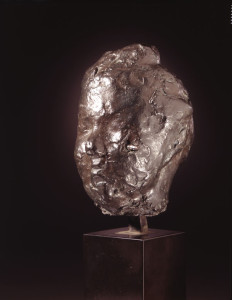
Head, Study for Portrait of Mme Salle, Hébrard bronze modèle cast from ca. 1892 wax. The subject is believed to have been a young dancer, Mathilde Salle.NORTON SIMON ART FOUNDATION
Bartholomé is also invoked to account for a statistical and historical improbability: Degas’s heirs selected 74 waxes to be cast in bronze from the approximately 150 sculptures remaining in the artist’s studio. According to Hedberg, Bartholomé had made plaster copies of Degas’s works beginning in the late 1880s, yet the Bartholomé/Valsuani plasters represent exactly the same 74 examples that were salvaged for casting after the artist’s death.
Maibaum offered his explanation for this unlikely outcome in a 2011 letter to ARTnews. “It is well known that in 1917–18 Bartholomé assisted the heirs in the decision-making process as to which of the waxes should be cast in bronze. Since Degas allowed Bartholomé to make plasters of certain waxes, it is logical to conclude that Bartholomé told the heirs which of the waxes Degas considered more or less ‘finished.’ And those are the ones which ultimately were cast in bronze–essentially the same figures as the plasters.”
But there is no evidence that Degas had ever “allowed Bartholomé to make plasters of certain waxes.” Thérèse Burollet, the leading authority on Bartholomé, who will soon publish a monograph and catalogue raisonné of his work, wrote in an email to ARTnews: “Nothing in the documents [I have] consulted, letters, archives, press articles or family traditions, allows one to think Bartholomé cast in plaster a single work by Degas either during his lifetime or in 1917” (the year of Degas’s death).
If Bartholomé did not cast early versions of sculptures Degas revised at a later date, how are we to explain the formal discrepancies between many of the Valsuani plasters and Degas’s surviving originals?
Maibaum has proposed yet another framework for assessing the status of the Valsuani plasters. In a paper not listed on the program but distributed at a colloquium on posthumous bronzes held last spring at the Hermitage Museum in Saint Petersburg, Maibaum argued that the critical question in determining the plasters’ authenticity is: “Were the plasters made from Degas’ waxes? If the answer is yes, the plasters are authentic. . . . In essence, if the physical evidence substantiates that the plasters were made from Degas’ waxes, they must be authentic, no matter if it can or cannot be determined as to who made them or when.”
The physical evidence Maibaum cites includes comparisons between the plasters and the inventory photographs of the waxes taken shortly after Degas’s death and some measurements comparing the plasters to a unique set of Degas bronze—the modèles—in the collection of the Norton Simon Museum in Pasadena, California.
The modèles are the first Degas bronzes cast at Hébrard. As Palazzolo explained in a 1955 interview, in order to preserve Degas’s handmade creations, he used flexible gelatin molds to make a set of duplicate wax models. These wax “intermodels” were melted in a lost-wax casting process used to create durable master bronzes—the modèles—from which series of bronzes were subsequently cast. Conservators Barbour and Sturman, who also published a detailed technical study of the Simon master bronzes in 2009, determined that these modèle bronzes were executed with great skill and in some cases now provide a more accurate record of Degas’s work than his extant waxes.
Hedberg made approximately 300 point-to-point measurements comparing the Valsuani plasters to the Simon master bronzes. Since bronze can shrink by approximately one to two percent as it cools, and plaster does not shrink, Maibaum reasoned that if the plasters turned out to be larger than the modèles, they were not cast from the modèles and could have been made directly from Degas’s handmade waxes. In most cases, Maibaum says, the plasters did turn out to be larger than the modèles. (According to the National Gallery conservators, it should be noted, plaster generally expands slightly as it dries.)
The logic of this argument is not easy to follow. Maibaum also states in his paper that if the plasters were copies of the modèles, “they would faithfully reproduce the dimensions, forms and details of the corresponding bronzes. They do not.”
Since the plasters do not match the forms of the modèle bronzes in some cases and the details of the bronzes in most cases, how could Hedberg make valid point-to-point measurements to compare these different objects? Furthermore, accurate measurements in three dimensions are difficult to attain without specialized technologies such as the three-dimensional laser scans utilized in the recent National Gallery studies of Degas’s sculpture.
The physical evidence provided by the 1917–18 inventory photographs Maibaum cites is difficult to assess as well. Seated Woman Wiping her Left Hip, for example, is missing her head in the 1917–18 inventory photograph, but the head was returned when Palazzolo made the modèle cast. The modèle retains a visible break in the back of the neck where the head was reattached, but there is no break in the neck of the corresponding Valsuani plaster.
In Maibaum’s view, this discrepancy tells us that the Valsuani plaster was probably cast prior to 1917, when the head was still attached. But the missing crack could just as easily be explained as an artistic decision made by Hedberg’s hypothetical copyist, who “sometimes made his or her own variations” of Degas’s models.
The inventory photographs raise other questions about the dealers’ claims. Comparing the existing wax, the inventory photo, and the modèle cast of Woman Washing Her Left Leg, for example, Barbour and Sturman ascertained that Degas’s original wax figure had been removed from its base when it was molded for bronze casting at Hébrard. A wax copy of the figure was made—an intermodel—and joined with a new flat base. Both were then cast together as a unit to create the master bronze.
This new base, a posthumous invention of the Hébrard Foundry, is imitated in the corresponding Valsuani plaster. It is difficult to imagine how the lifetime sculpture said to be represented in the Valsuani plaster could have anticipated revisions made, probably by Palazzolo, years after the artist’s death. Similar questions can be raised about the bases for the Valsuani casts of Horse Trotting, the Feet Not Touching the Ground and Dancer in the Role of Harlequin.
The inventory photograph of Dancer Ready to Dance, the Right Foot Forward presents another kind of challenge. In the photograph, a substantial external armature extends from the base of the sculpture to the top of the figure’s head. Large wires attached to this metal rod hold each arm in a curved position around the head. “When the external armature was removed before casting,” Sturman and Barbour observed in their text, “the left arm drooped so that it is now rendered almost perpendicular to the body in a compromise of the original intent.” The drooping left arm is in the same position in the Valsuani plaster. Why didn’t the “lifetime” plaster preserve the artist’s original intent instead of replicating an error that resulted from the casting process years after the artist’s death?
Returning to Hedberg’s proposals about the origins of the Valsuani plasters and reviewing relevant art-historical and technical evidence, we can ask which option is more likely: that the plasters are posthumous freehand copies of Hébrard bronzes or that they were cast from various versions of Degas’s original waxes while he was still alive. If the plasters were cast from Degas’s handmade figures after the artist’s death, and without permission of the artist or his heirs, do they still count as “authentic”?
The National Gallery’s published studies do not confirm Hedberg’s assertion that the Little Dancer photographed in Degas’s studio after his death, and now in the National Gallery, is a revised second version of an earlier level-hipped, large-legged, more static figure with a different pose and face. Furthermore, drawings of the nude model for the sculpture made in the years just before the Little Dancer was first shown, in 1881, clearly resemble the figure and pose in the National Gallery sculpture.
There is no historical evidence of Bartholomé’s involvement with the Valsuani plasters, raising serious doubts about the dealers’ explanation for the one-to-one correspondence between the set of 74 examples chosen for casting at Hébrard after Degas’s death and the 74 examples represented by the Valsuani plasters.
The measurements and other physical evidence Maibaum cites to support his contention that the plasters were cast from the original waxes are inconclusive, and he does not explain how and when the plasters could have been made, if not by Bartholomé.
There could be interpretations of the history of the Valsuani plasters other than those Hedberg proposes, but at this point the theory that the plasters are post-humous freehand copies modeled after the Hébrard bronzes appears to be the most plausible one. The freehand-copy theory accounts for many of the large and small formal differences between the Valsuani plasters, the Hébrard bronzes, and Degas’s handmade waxes. It also explains the one-to-one correspondence between the set of Valsuani plasters and the 74 examples selected for casting after the artist’s death.
Valsuani Foundry records document casts of Degas sculpture made at Valsuani by Palazzolo in the 1950s and ’60s. Although the Hébrard Foundry, where Palazzolo cast Degas bronzes after the artist’s death, closed in the mid-1930s, Palazzolo continued to mark the casts he made years later at Valsuani with the stamp of the old Hébrard Foundry. Since Palazzolo must have brought the Hébrard master bronzes to Valsuani in order to create these new casts, a complete set of possible models for copyists could have been available at Valsuani for decades.
While such speculations remain unconfirmed, the status of the Valsuani casts seems to be suspended in a gap between two concepts of “original”: the plasters as first and lifetime records of Degas’s sculptural oeuvre versus the plasters as independently created interpretations, variations, or emulations of Degas’s work by another hand (or hands). The plasters’ origin remains unknown, but careful assessments of relevant evidence may point the way toward a future resolution.
Patricia Failing is a professor of art history at the University of Washington in Seattle and an ARTnews contributing editor.
Copyright 2013, ARTnews LLC, 48 West 38th St 9th FL NY NY 10018. All rights reserved.
Source: www.artnews.com
